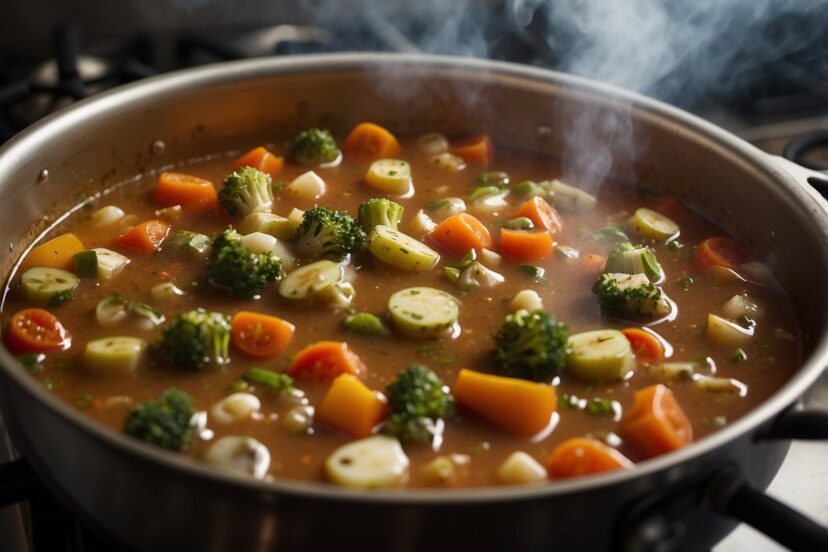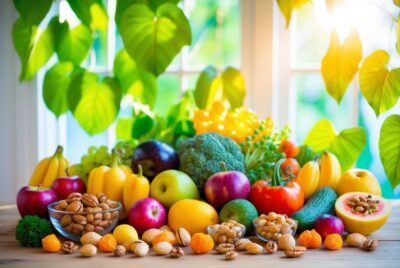Vegetarian Gumbo: A Flavorful Twist
*We may earn a commission for purchases made using our links. Please see our disclosure to learn more.
Vegetarian Gumbo: A Flavorful Twist on a Classic Recipe
Vegetarian gumbo might seem like a daunting dish, but it’s surprisingly simple and incredibly satisfying. This rich and flavorful stew, darkened by a carefully crafted roux, features an array of vegetables like okra, mushrooms, and cauliflower. Beyond its taste, the dish is a fantastic way to celebrate Mardi Gras or enjoy a cozy meal at home.

I’ve found that the key to a great vegetarian gumbo is in the preparation of the roux and the combination of fresh, hearty vegetables. By roasting okra or using a mix of colorful bell peppers, you can create layers of flavor that make the gumbo truly stand out. Whether you’re a longtime vegetarian or just looking for a new recipe to try, this gumbo offers a delicious, plant-based twist on a classic.
What’s even better is that this meal is adaptable to various dietary needs. You can make it vegan, gluten-free, or pair it with different sides like rice, cornbread, or bread. So gather your ingredients, and let’s dive into creating a gumbo that’s both traditional and unique!
Origins of Vegetarian Gumbo

Vegetarian gumbo has its roots in traditional gumbo but adapts to exclude meat and seafood. Learn how this flavorful dish maintains cultural ties while respecting dietary choices.
Historical Roots
The history of gumbo dates back to the early 1800s in Louisiana. Traditionally, gumbo was a Creole dish made with meat or seafood, thickened with okra, filé powder, or roux. Vegetarian gumbo took shape as people adapted these recipes to meet dietary preferences and restrictions.
In its essence, vegetarian gumbo keeps the classic techniques. The roux, a mixture of flour and fat, is a key component. By using fresh vegetables and spices, this version maintains the gumbo’s distinctive flavor. The inclusion of greens, mirroring traditional practices, is central to many vegetarian versions.
Cultural Significance
Gumbo is more than just food; it’s part of Louisiana’s cultural identity. Vegetarian gumbo respects these traditions while expanding the dish’s reach. It allows participation in cultural cuisine without compromising personal dietary choices.
For many, vegetarian recipes offer a way to celebrate regional heritage inclusively. This approach makes it possible to share the dish at diverse gatherings, accommodating various dietary needs. By preserving traditional elements, vegetarian gumbo ensures that the cultural significance of the dish remains strong.
Core Ingredients of Vegetarian Gumbo

Vegetarian gumbo relies on a flavorful vegetable base, effective thickening agents, and a blend of spices and seasonings. Each plays a key role in creating the taste and texture unique to this beloved dish.
Vegetable Base
The heart of a good vegetarian gumbo is its vegetable base. I like to start with the holy trinity of Creole cooking: onions, bell peppers, and celery. These three vegetables offer a solid foundation of flavor and aroma.
Other key vegetables include tomatoes, okra, and mushrooms. Okra is especially important as it also acts as a thickener. Adding carrots and zucchini can provide extra texture and color. Combining these vegetables creates a vibrant and hearty base that holds up well in the cooking process.
Thickening Agents
To achieve the classic gumbo texture, thickening agents are crucial. Roux is a traditional thickening agent made by slowly cooking flour and fat until it turns a deep brown color. This adds depth and richness to the gumbo.
Okra and tomatoes also help in thickening the gumbo naturally. For those avoiding flour, file powder made from ground sassafras leaves is another excellent option. Balancing these agents ensures the gumbo has the right consistency and holds together well.
Spices and Seasonings
The distinct taste of gumbo comes from its spices and seasonings. Thyme, bay leaves, cayenne pepper, and paprika are essential in building layers of flavor. Adding a pinch of salt and freshly ground black pepper helps to season the base vegetables.
For an authentic Creole flavor, incorporating file powder or a good Cajun seasoning mix is key. Don’t forget the garlic and a hint of smoked paprika for that extra smoky touch. These spices blend to create a rich, savory gumbo that bursts with flavor with every bite.
Cooking Techniques

When making vegetarian gumbo, two crucial techniques stand out: preparing the roux and perfecting the simmering process. Each step requires attention to detail to ensure a flavorful, hearty dish.
Roux Preparation
Making a good roux is key. I start by whisking together oil and flour in a medium pot. Over medium heat, continue to whisk frequently. The goal is to get the mixture to the color of butterscotch; this can take about 10 minutes.
Once the roux reaches the right color, onions, celery, and bell pepper are added. Season with salt and stir until the vegetables soften, which takes around 8 minutes. This step forms the base of the gumbo, adding depth and richness to the flavor.
Simmering Methods
After adding tomatoes and Creole seasoning, it’s essential to let the gumbo simmer. I bring the soup to a boil first, then lower the heat to medium-low. Adding ingredients like cauliflower and mushrooms at this stage lets them absorb the spices.
Simmering should last 5-10 minutes until the vegetables are tender. This ensures all the flavors meld together smoothly. I like to use frozen okra, roasted in the oven for 15-20 minutes beforehand, and then add it to the simmering pot. This keeps the okra firm and enhances the texture of the gumbo.
Variant Recipes

Vegetarian gumbo can be made in different styles, mainly Creole and Cajun. Each has unique characteristics and ingredients, creating varied tastes and textures.
Creole-Style
Creole-style vegetarian gumbo often has a richer, tomato-based flavor. I start by heating oil in a pot and adding a roux made from flour and fat. I then sauté onions, bell peppers, and celery, commonly known as the “holy trinity.”
Tomatoes and okra are essential in this style. After the vegetables soften, I add tomatoes, vegetable broth, and okra. For seasoning, I use thyme, paprika, and a bay leaf. The gumbo continues to cook until all vegetables are tender.
This version also includes beans, mushrooms, and sometimes zucchini. It has a hearty and comforting flavor, perfect for those looking for a rich, satisfying dish.
Cajun-Inspired
Cajun-inspired gumbo tends to have a smoky, spiced profile. I begin by creating a darker roux, cooked longer to develop deep flavors. The “holy trinity” of onions, celery, and bell peppers is also essential here.
In this style, I often use ingredients like vegan sausage and a range of spices, such as cayenne pepper, to give it a kick. I add vegetable stock, followed by vegetables like mushrooms, green and red peppers, and sometimes zucchini.
The gumbo simmers until all elements are well-cooked. The robust flavor makes this version a favorite among those who enjoy a bit of spice and smokiness in their meals.
Serving Suggestions

When serving Vegetarian Gumbo, pairing it with complementary sides and presenting it attractively on the plate can elevate the meal.
Accompaniments
To enhance the gumbo experience, serve it with rice. Long-grain or brown rice works well and soaks up the flavors. You could also offer crusty bread or cornbread on the side, providing a satisfying contrast to the dish’s texture.
Another great side is a fresh green salad with a light vinaigrette. This can balance the hearty gumbo.
For a Southern touch, consider adding fried okra or sweet potato fries. Both add unique flavors that complement the gumbo. Hot sauce can be placed on the table for those who enjoy an extra kick.
Presentation Tips
For a visually appealing plate, serve the gumbo in a deep bowl, allowing the mix of vegetables and broth to shine. Sprinkle chopped green onions or fresh parsley on top for a pop of color.
Use contrasting colors on the tablecloth and napkins to make the dish stand out.
Ladle the gumbo carefully to keep the vegetables and broth balanced in each serving. Additionally, place the accompaniments in separate dishes or containers to let everyone customize their meal.
Using rustic wooden boards or platters can give a homey, comforting feel to the presentation.
Frequently Asked Questions
Vegetarian gumbo is a flavorful dish that can be made with a variety of vegetables and spices. It can capture the essence of New Orleans cuisine without meat.
1. What are the essential ingredients for a vegetarian gumbo?
Essential ingredients include vegetables like cauliflower, mushrooms, tomatoes, bell peppers, and okra. Seasonings such as thyme, cayenne pepper, and bay leaves are vital for the flavor. A good vegetable broth is also important for the base.
2. How can I make a vegetarian gumbo with authentic New Orleans flavor?
To achieve authentic New Orleans flavor, use the traditional “holy trinity” of Cajun cooking: onions, bell peppers, and celery. Adding spices like thyme, cayenne, and bay leaves will bring out the taste. Cooking time and slow simmering are key factors for deep flavors.
3. What are some easy steps to prepare a quick vegetarian gumbo at home?
Start by sautéing onions, celery, and bell peppers. Add garlic and spices, followed by mixed vegetables like cauliflower and mushrooms. Pour in vegetable broth and simmer. Add rice or serve over cooked rice. Adjust seasoning as needed.
4. Can I use okra in a vegetarian gumbo, and if so, how?
Yes, okra can be used in vegetarian gumbo. Slice it and add it during the cooking process. It helps to thicken the gumbo and adds a unique texture and flavor. Cook it until it is tender but not mushy.
5. What is the best way to cook vegetarian gumbo in a slow cooker?
To cook in a slow cooker, add all the vegetables, spices, and broth to the cooker. Set it on low for 6-8 hours or high for 3-4 hours. Stirr occasionally. Ensure the vegetables are tender before serving. This method allows the flavors to develop fully.




